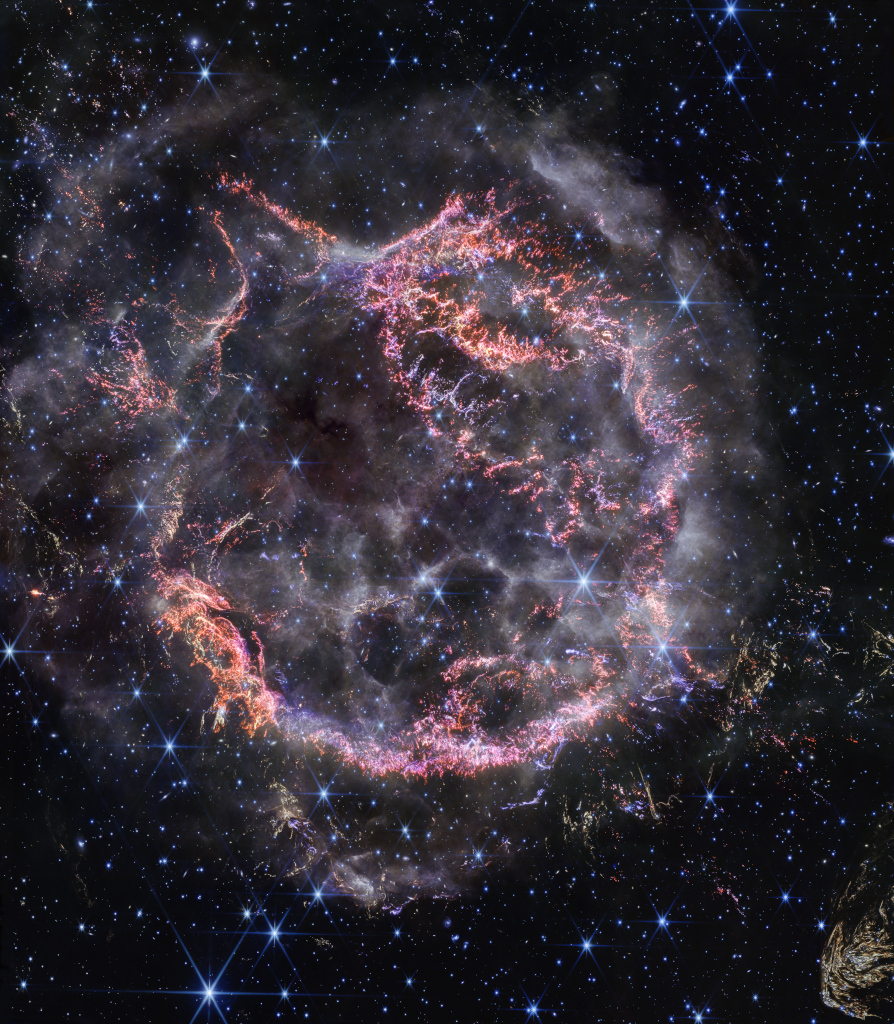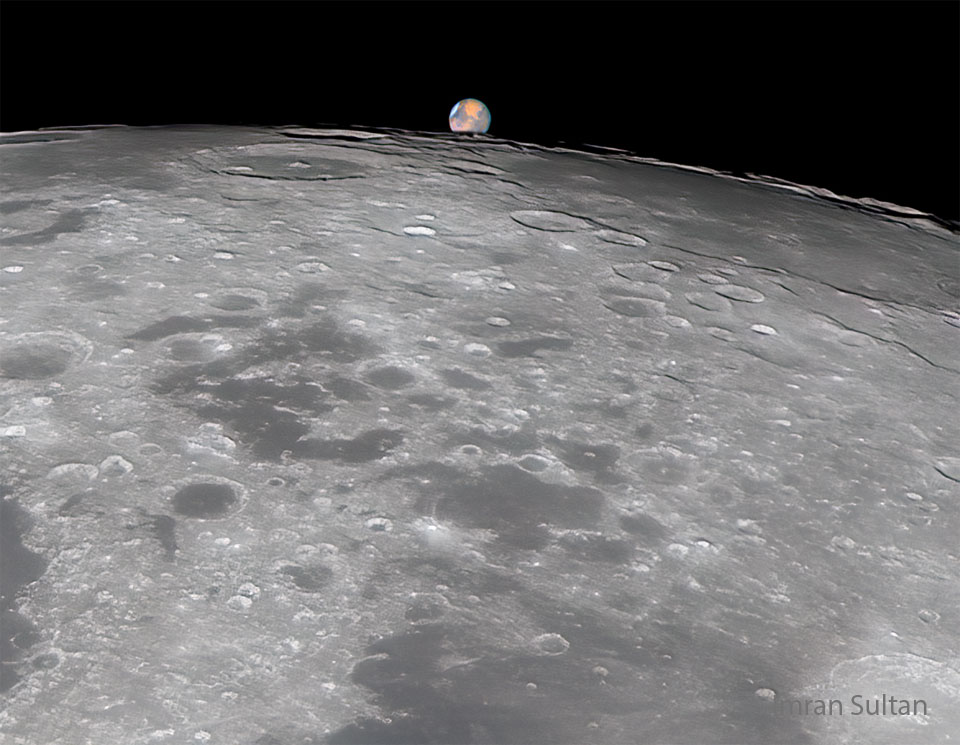Η Αστρονομική Εικόνα της Ημέρας από τη NASA
A Solstice Sun Tattoo
20/12/2025
The word solstice is from the Latin for Sun and to pause or stand still. And in the days surrounding a solstice the Sun's annual north-south drift in planet Earth's sky does slow down, pause, and then reverse direction. So near the solstice the daily path of the Sun through the sky really doesn't change much. In fact, near the December solstice, the Sun's consistent, low arc through northern hemisphere skies, along with low surface temperatures, has left a noticeable imprint on this path to the mountain town of Peaio in northern Italy. The morning frost on the road has melted away only where the sunlight was able to reach the ground. But it remains in the areas persistently shadowed by the fence, tattooing in frost an image of the fence on the asphalt surface.
Copyright: Marcella Pace
Προηγούμενες Αστρονομικές Εικόνες της Ημέρας από τη NASA
The North America Nebula
22/01/2025
The North America nebula on the sky can do what the North America continent on Earth cannot -- form stars. Specifically, in analogy to the Earth-confined continent, the bright part that appears as the east coast is actually a hot bed of gas, dust, and newly formed stars known as the Cygnus Wall. The featured image shows the star forming wall lit and eroded by bright young stars and partly hidden by the dark dust they have created. The part of the North America nebula (NGC 7000) shown spans about 50 light years and lies about 1,500 light years away toward the constellation of the Swan (Cygnus). Jigsaw Challenge: Astronomy Puzzle of the Day
Copyright: Dimitris Valianos
Comet ATLAS over Brasília
21/01/2025
What's that in the sky? Above the city, above most clouds, far in the distance: it's a comet. Pictured, the impressive tail of Comet C/2024 G3 (ATLAS) was imaged from Brasília, Brazil four days ago. Last week the evolving comet rounded the Sun well inside the orbit of planet Mercury, going so close there was early concern that it might break up -- and recent evidence that it really did. At one point near perihelion, Comet ATLAS was so bright that sightings were even reported during the day -- over the bright sky near the Sun -- by careful observers. Over the past few days, Comet ATLAS has developed a long tail that has been partly visible with unaided eyes after sunset, most notably in Earth's southern hemisphere. Growing Gallery: Comet ATLAS (G3)
Copyright: NASA
Comet ATLAS Rounds the Sun
20/01/2025
Why does Comet ATLAS have such colorful tails? Last week Comet C/2024 G3 (ATLAS) passed its closest to the Sun -- well inside the orbit of Mercury -- and brightened dramatically. Unfortunately, the comet was then so angularly near the Sun that it was very hard for humans to see. But NASA's SOHO spacecraft saw it. Pictured is a SOHO (LASCO C3) image of Comet ATLAS that is a composite of several different color filters. Of the several tails visible, the central white tails are likely made of dust and just reflecting back sunlight. The red, blue, and green tails are likely ion tails with their colors dominated by light emitted by specific gases that were ejected from the comet and energized by the Sun. Currently, Comet ATLAS is showing long tails in southern skies but fading as it moves out of the inner Solar System. Growing Gallery: Comet ATLAS (G3)
Copyright: NASA
Full Moon, Full Mars
18/01/2025
On January 13 a Full Moon and a Full Mars were close, both bright and opposite the Sun in planet Earth's sky. In fact Mars was occulted, passing behind the Moon, when viewed from some locations in North America and northwest Africa. As seen from Richmond, Virginia, USA, this composite image sequence follows the evening lunar occultation before, during, and after the much anticipated celestial spectacle. The telescopic time series is constructed from an exposure made every two minutes while tracking the Moon over the hours encompassing the event. As a result, the Red Planet's trajectory seems to follow a gently curved path due to the Moon's slightly different rate of apparent motion. The next lunar occultation of bright planet Mars will be on February 9 when the moon is in a waxing gibbous phase. Lunar occultations are only ever visible from a fraction of the Earth's surface, though. The February 9 occultation of Mars will be seen from parts of Russia, China, eastern Canada, Greenland and other (mostly northern) locations, but a close conjunction of a bright Moon with Mars will be more widely visible from planet Earth. Growing Gallery: Moon-Mars Occultation in January 2025
Copyright: On January 13
Supernova Remnant Cassiopeia A
17/01/2025
Massive stars in our Milky Way Galaxy live spectacular lives. Collapsing from vast cosmic clouds, their nuclear furnaces ignite and create heavy elements in their cores. After only a few million years for the most massive stars, the enriched material is blasted back into interstellar space where star formation can begin anew. The expanding debris cloud known as Cassiopeia A is an example of this final phase of the stellar life cycle. Light from the supernova explosion that created this remnant would have been first seen in planet Earth's sky about 350 years ago, although it took that light 11,000 years to reach us. This sharp NIRCam image from the James Webb Space Telescope shows the still hot filaments and knots in the supernova remnant. The whitish, smoke-like outer shell of the expanding blast wave is about 20 light-years across. A series of light echoes from the massive star's cataclysmic explosion are also identified in Webb's detailed images of the surrounding interstellar medium.
Copyright: NASA
M83: The Southern Pinwheel
16/01/2025
Beautiful and bright spiral galaxy M83 lies a some twelve million light-years away, near the southeastern tip of the very long constellation Hydra. Prominent spiral arms traced by dark dust lanes and blue star clusters lend this galaxy its popular name, The Southern Pinwheel. Still, reddish star forming regions that dot this cosmic pinwheel's spiral arms have suggested another nickname, the Thousand-Ruby Galaxy. A mere 40,000 light-years across, smaller than the Milky Way, M83 is a member of a group of galaxies that includes active galaxy Centaurus A. In fact, the core of M83 itself is bright at x-ray energies, showing a high concentration of neutron stars and black holes left from an intense burst of star formation. This sharp color image also features spiky foreground Milky Way stars and distant background galaxies. The image data was captured with the Dark Energy Camera and Blanco 4-meter telescope at Cerro Tololo Inter-American Observatory.
Copyright: NASA
Wolf Moon Engulfs Mars
15/01/2025
Does the Moon ever engulf Mars? Yes, but only in the sense that it moves in front, which happens on rare occasions. This happened just yesterday, though, as seen from some locations in North America and western Africa. This occultation was notable not only because the Moon was a fully lit Wolf Moon, but because Mars was near its largest and brightest, moving to opposition -- the closest to the Earth in its orbit -- only tomorrow. The engulfing, more formally called an occultation, typically lasting about an hour. The featured image was taken from near Chicago, Illinois, USA just as Earth's largest satellite was angularly moving away from the much more distant red planet. Our Moon occasionally moves in front of all of the Solar System's planets. Given the temporary alignment of orbital planes, the next time our Moon eclipses Mars will be a relatively soon February 9. Growing Gallery: Moon-Mars Occultation in January 2025
Copyright: Imran Sultan
North Star: Polaris and Surrounding Dust
14/01/2025
Why is Polaris called the North Star? First, Polaris is the nearest bright star toward the north spin axis of the Earth. Therefore, as the Earth turns, stars appear to revolve around Polaris, but Polaris itself always stays in the same northerly direction -- making it the North Star. Since no bright star is near the south spin axis of the Earth, there is currently no bright South Star. Thousands of years ago, Earth's spin axis pointed in a slightly different direction so that Vega was the North Star. Although Polaris is not the brightest star on the sky, it is easily located because it is nearly aligned with two stars in the cup of the Big Dipper. Polaris is near the center of the five-degree wide featured image, a digital composite of hundreds of exposures that brings out faint gas and dust of the Integrated Flux Nebula (IFN) all over the frame. The surface of Cepheid Polaris slowly pulsates, causing the famous star to change its brightness by a few percent over the course of a few days. Today: Zoom APOD Lecture hosted by the Amateur Astronomers of Association of New York
Copyright: Davide Coverta
Η Αστρονομική Εικόνα της Ημέρας από τη NASA (NASA Astronomy Picture of the Day) είναι μια δωρεάν υπηρεσία που παρέχει καθημερινά μια εντυπωσιακή εικόνα από το σύμπαν, την λήψη της οποίας έχει πραγματοποιήσει κάποιος από τους αστρονόμους της NASA ή από κάποιον από τους δορυφόρους ή τα τηλεσκόπια που η NASA λειτουργεί. Οι εικόνες που εμφανίζονται καλύπτουν μια ευρεία γκάμα από θέματα, συμπεριλαμβανομένων των αστερισμών, των γαλαξιών, των πλανητικών συστημάτων, των κομητών, των αστρικών σωμάτων και των παρατηρητηρίων. Κάθε εικόνα συνοδεύεται από μια σύντομη εξήγηση και πληροφορίες σχετικά με το τι παρατηρείται στην εικόνα.








